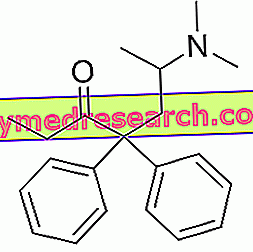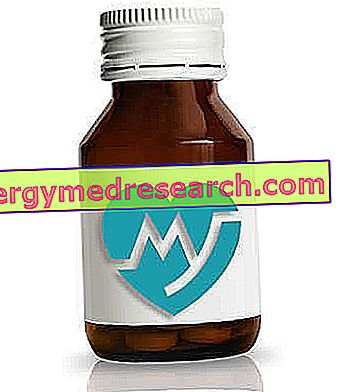Generality
Methadone is a drug belonging to the class of analgesics (or painkillers) opioids. Its analgesic power is similar to that of morphine, but - unlike the latter - methadone is not of natural origin, but is a synthetic drug.

Methadone - Chemical Structure
Methadone - in addition to being used in pain therapy - is also used in the treatment of drug addiction to reduce the typical symptoms of withdrawal symptoms.
Methadone is available in pharmaceutical formulations suitable for both oral and parenteral administration.
From the chemical point of view, methadone can be considered as a derivative of diphenylpropilamine.
Examples of medicinal specialties containing methadone
- Eptadone ®
- Misyo ®
- Methadone hydrochloride Molteni ®
Indications
For what it uses
The use of methadone is indicated for the treatment of severe pain in those patients who do not respond to treatments with other pain medications, such as NSAIDs and other opioid analgesics with less potency.
Furthermore, methadone is used in substitution treatment for narcotics (such as heroin) or other opioid analgesics (such as morphine) to reduce the symptoms triggered by withdrawal symptoms.
Warnings
Methadone can cause physical and mental dependence and tolerance similar to morphine. For this reason, all necessary precautions must be taken to avoid its occurrence.
The use of methadone in patients with intracranial hypertension should be avoided, as there is a greater risk of onset of respiratory depression and increased cerebrospinal fluid pressure.
Even in patients suffering from respiratory diseases or with ongoing asthma attacks, the use of methadone should be avoided, since the drug can reduce respiratory stimuli and increase airway resistance up to apnea.
Methadone can cause severe hypotension in patients with hypovolaemia and in patients already being treated with certain types of neuroleptic or anesthetic drugs.
Extreme caution should be used in the administration of opioid receptor antagonists (such as, for example, naloxone and naltrexone) in patients who have developed a physical dependence on methadone, since the administration of these drugs can trigger a withdrawal syndrome.
Furthermore, in elderly and debilitated patients, in patients suffering from hypothyroidism, Addison's disease, urethral stricture or prostatic hypertrophy, a reduction in methadone doses usually used in therapy may be necessary.
Alcohol intake during methadone therapy should be avoided, as there may be an increase in side effects induced by the same drug. Furthermore, during treatment with the drug, the intake of grapefruit juice should be avoided, since the latter can alter the effect of the methadone itself.
Methadone is capable of altering the ability to drive and use machines, therefore, during treatment with the drug these activities should be avoided.
Finally, for those who carry out sporting activities, the use of methadone without therapeutic necessity is doping and in any case can lead to positive doping tests even when taken for therapeutic purposes.
Interactions
Methadone should not be used in patients who are taking - or have taken in the last two weeks - monoamine oxidase inhibitors (or MAOIs, drugs used to treat Parkinson's disease and depression).
Methadone is metabolised in the liver mainly by cytochrome P3A4. The concomitant administration of methadone and inducing drugs of the aforementioned cytochrome can cause an increase in hepatic metabolism of the same methadone, with consequent onset of withdrawal symptoms. Among the inducers of cytochrome P3A4, we recall:
- Barbiturates ;
- Carbamazepine and phenytoin, antiepileptic drugs;
- Nevirapine, zidovudine, ritonavir and efavirenz, antiviral drugs;
- Dexamethasone ;
- Preparations based on St. John 's wort (or St. John's wort, a plant with antidepressant properties).
In contrast, the concomitant administration of methadone and cytochrome P3A4 inhibitor drugs favors an increase in levels of the same methadone. Among these drugs, we recall:
- Erythromycin, clarithromycin and other macrolide antibiotics;
- Fluconazole, itraconazole and ketoconazole, antifungal drugs;
- SSRIs (selective serotonin reuptake inhibitors, antidepressant drugs);
- Nefazodone, another antidepressant;
- Cimetidine, a drug used to reduce acid secretion of the stomach.
Also, before starting methadone treatment, it is advisable to tell your doctor if you are already taking any of the following medications:
- Other opioid analgesics ;
- Opioid receptor partial antagonists or agonists, such as naloxone, naltrexone and buprenorphine ;
- Verapamil, quinidine and other drugs used to treat cardiovascular diseases;
- Immunosuppressive drugs, such as cyclosporine ;
- Anti- inflammatory drugs;
- Antiviral drugs;
- Quinolones, antibiotic drugs;
- Rifampicin, an antibiotic used to treat tuberculosis;
- Antiepileptics ;
- Antidiarrheal (such as, for example, loperamide);
- Diuretics ;
- Hypnotic sedative drugs.
However, it is still good to inform your doctor if you are taking - or have recently been taken - any type of medication, including prescription free medicines and herbal and homeopathic products.
Side effects
Methadone can cause different types of side effects, although not all patients experience them. This is due to the different sensitivity that each individual has towards the drug. Therefore, it is not said that the adverse effects occur all with the same intensity in each person.
The main side effects that may occur during methadone therapy are listed below.
Allergic reactions
Methadone can trigger allergic reactions in sensitive individuals. These reactions can occur in the form of angioedema, difficulty in breathing, difficulty swallowing and severe skin itching.
Cardiovascular disorders
Methadone treatment can promote the onset of:
- Cardiac rhythm disorders;
- Hypotension;
- Orthostatic hypotension;
- Syncope;
- bradycardia;
- Palpitations;
- Circulatory depression;
- Cardiac arrest;
- Prolongation of the QT interval (the interval of time necessary for the ventricular myocardium to depolarize and repolarize).
Lung and respiratory tract disorders
During methadone therapy, the following may occur:
- Difficulty breathing, sometimes accompanied by coughing;
- Dry nose;
- Respiratory depression;
- Respiratory arrest;
- Worsening of asthma in patients who are affected.
Gastrointestinal disorders
Methadone treatment can cause nausea, vomiting, reduced intestinal motility and constipation.
Nervous system disorders
Methadone therapy can cause:
- Dizziness and / or dizziness;
- Feeling of emptiness in the head;
- Sedation;
- Headache;
- Weakness;
- Disorientation.
Psychiatric disorders
Methadone treatment can cause euphoria or dysphoria, agitation and insomnia.
Skin and subcutaneous tissue disorders
Methadone therapy can help the appearance of:
- Transient skin rash;
- Itch;
- Urticaria;
- Edema;
- Hemorrhagic urticaria (rarely).
Other side effects
Other side effects that may occur during treatment with methadone are:
- Tolerance and dependence (both physical and mental);
- Spasm of biliary tract;
- Urinary retention;
- Libido reduction;
- Impotence;
- Amenorrhea;
- Dry mouth;
- Inflammation of the tongue (when the drug is taken orally);
- Hypothermia.
Overdose
In case of overdose of methadone they can occur:
- Extreme drowsiness that can reach astonishment and coma;
- Respiratory depression;
- Miosi;
- Skeletal muscle flaccidity;
- bradycardia;
- Hypotension;
- Cold and sweaty skin.
In the event of an overdose it is essential to restore the respiratory function immediately and to combat intoxication opioid receptor antagonists (such as, for example, naloxone) can be administered.
In any case, if methadone overdose is suspected, contact your doctor immediately or contact the nearest hospital.
Action mechanism
Methadone is a powerful agonist of μ opioid receptors and exerts its analgesic action in a similar way to that of morphine. However, compared to the latter, methadone has a longer duration of action and greater power when administered orally.
The opioid μ receptors are located along the pain pathways present within our body and their task is precisely to modulate the neurotransmission of painful stimuli. More in detail, when these receptors are stimulated, analgesia is induced.
Therefore, methadone - as a selective agonist of the aforementioned receptors - is able to activate them thus exerting its pain-relieving action.
The fact that methadone is a selective μ receptor agonist and has good oral bioavailability and a long duration of action, makes it a very useful drug also for reducing symptoms caused by withdrawal syndrome in patients with opioid dependence.
Mode of Use - Posology
Methadone is available for oral administration (in the form of oral solution and syrup) and for parenteral administration (in the form of an injectable solution).
Because it can cause addiction, patients should be monitored and controlled to verify that the drug is not used improperly during methadone treatment.
Following are some indications on the doses of methadone usually used in therapy.
Reduction of withdrawal symptoms
Methadone is usually used to reduce symptoms of withdrawal in patients with opioid dependence.
Generally, the treatment begins with an initial dose of 10-30 mg a day which will then be gradually increased to 60-120 mg a day.
The doctor must determine for each patient the dose of drug to be taken, the frequency of administration and the duration of treatment.
Treatment of severe pain
For the treatment of severe pain methadone can be used orally or parenterally.
When the drug is used orally, the dose normally used is 5-10 mg, to be taken several times a day according to the indications provided by the doctor.
When methadone is used parenterally, the dose of medication usually used is 2.5-10 mg to be administered intramuscularly or subcutaneously every 3-4 hours, as needed.
In any case, it is always necessary to follow all the indications provided by the doctor.
Pregnancy and breastfeeding
Due to the adverse effects it can cause, the use of the drug is generally contraindicated during pregnancy (especially during labor) and during lactation.
Contraindications
The use of methadone is contraindicated in the following cases:
- In patients with known hypersensitivity to the same methadone or to other drugs with a chemical structure similar to that of methadone;
- In patients with ongoing asthma attack;
- In patients with chronic constipation;
- In patients with porphyria;
- In patients with uncontrolled diabetes;
- In patients taking - or who have recently taken - monoamine oxidase inhibitor (MAOI) drugs;
- In patients with alcohol and / or opioid dependence;
- In patients with QT interval prolongation and in patients with heart disease;
- In patients with intracranial hypertension;
- In patients with chronic obstructive pulmonary disease (COPD), pulmonary heart disease or pulmonary insufficiency;
- In patients suffering from severe liver and / or renal disorders;
- Pregnant;
- During breastfeeding.



